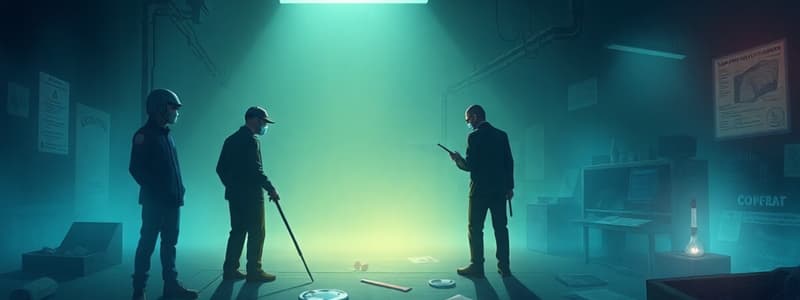Podcast
Questions and Answers
What is the primary focus of forensic science as described in the course?
What is the primary focus of forensic science as described in the course?
The primary focus of forensic science is the application of scientific knowledge to solve civil and criminal legal questions.
Name two important roles of professionals in forensic science when evaluating a crime scene.
Name two important roles of professionals in forensic science when evaluating a crime scene.
Two important roles are collecting evidence while maintaining the chain of custody and analyzing the collected evidence.
What does 'preservation of chain of custody' refer to in forensic science?
What does 'preservation of chain of custody' refer to in forensic science?
It refers to maintaining a documented trail of evidence from the crime scene to the court, ensuring its integrity.
How does information technology impact forensic science?
How does information technology impact forensic science?
What is the significance of presenting evidence in a professional manner?
What is the significance of presenting evidence in a professional manner?
Mention one emerging trend in forensic science that students in this course may research.
Mention one emerging trend in forensic science that students in this course may research.
What are some basic components of several sub-fields of forensic science that students will assess?
What are some basic components of several sub-fields of forensic science that students will assess?
Explain the importance of understanding the organization of a crime laboratory.
Explain the importance of understanding the organization of a crime laboratory.
What is the significance of assessing a suspect's state of mind during the commission of a crime?
What is the significance of assessing a suspect's state of mind during the commission of a crime?
What are two common types of death classified in forensic pathology?
What are two common types of death classified in forensic pathology?
Describe the role of a toxicologist in forensic toxicology.
Describe the role of a toxicologist in forensic toxicology.
What distinguishes forensic odontology from other forensic disciplines?
What distinguishes forensic odontology from other forensic disciplines?
What are the three different types of microscopes mentioned in forensic science?
What are the three different types of microscopes mentioned in forensic science?
Explain the importance of chain of custody in evidence collection.
Explain the importance of chain of custody in evidence collection.
What is one technique used to determine the time of death?
What is one technique used to determine the time of death?
What type of evidence can hair and fiber analysis provide in criminal investigations?
What type of evidence can hair and fiber analysis provide in criminal investigations?
What is the purpose of psychological profiling in forensic psychology?
What is the purpose of psychological profiling in forensic psychology?
What is the principle introduced by Locard, and why is it important in forensic science?
What is the principle introduced by Locard, and why is it important in forensic science?
Identify two techniques used in forensic toxicology for drug identification.
Identify two techniques used in forensic toxicology for drug identification.
In what contexts is forensic anthropology utilized?
In what contexts is forensic anthropology utilized?
What are the main responsibilities of the First Responding Officer at a crime scene?
What are the main responsibilities of the First Responding Officer at a crime scene?
What significance do botanical remains have in forensic investigations?
What significance do botanical remains have in forensic investigations?
How can forensic entomology assist in investigating a crime?
How can forensic entomology assist in investigating a crime?
Flashcards
What is forensic science?
What is forensic science?
Applying scientific principles to legal issues, particularly in criminal investigations. This involves analyzing evidence found at crime scenes and in lab settings to help solve crimes.
Branches of forensic science
Branches of forensic science
Specialized areas within forensic science, each focusing on specific types of evidence. Some examples include ballistics, DNA analysis, and toxicology.
What is a crime laboratory?
What is a crime laboratory?
A facility dedicated to analyzing evidence collected from crime scenes. It houses different labs and departments, each with its own expertise.
What is the chain of custody?
What is the chain of custody?
Signup and view all the flashcards
What does a forensic scientist do?
What does a forensic scientist do?
Signup and view all the flashcards
Presenting evidence in court
Presenting evidence in court
Signup and view all the flashcards
Data collection in forensic science
Data collection in forensic science
Signup and view all the flashcards
What is contamination in forensic science?
What is contamination in forensic science?
Signup and view all the flashcards
Natural Death
Natural Death
Signup and view all the flashcards
Accidental Death
Accidental Death
Signup and view all the flashcards
Suicide
Suicide
Signup and view all the flashcards
Homicide
Homicide
Signup and view all the flashcards
Autopsy
Autopsy
Signup and view all the flashcards
Rigor Mortis
Rigor Mortis
Signup and view all the flashcards
Algor Mortis
Algor Mortis
Signup and view all the flashcards
Livor Mortis
Livor Mortis
Signup and view all the flashcards
Stereoscopic Microscope
Stereoscopic Microscope
Signup and view all the flashcards
Polarizing Microscope
Polarizing Microscope
Signup and view all the flashcards
Forensic Entomology
Forensic Entomology
Signup and view all the flashcards
Compound Microscope
Compound Microscope
Signup and view all the flashcards
Comparison Microscope
Comparison Microscope
Signup and view all the flashcards
Scanning Electron Microscope (SEM)
Scanning Electron Microscope (SEM)
Signup and view all the flashcards
Pharmacokinetics
Pharmacokinetics
Signup and view all the flashcards
Study Notes
Forensic Science Course - CJUS1301
- Course Overview:
- Forensic science applies scientific knowledge to legal issues (civil and criminal).
- This practical course focuses on crime scene evidence collection, analysis, and court testimony.
- Students learn innovative techniques and methods to analyze and interpret evidence, with a focus on clarity and concise communication.
- Required lab reports explain results and significance.
- Course duration: 3 credits, 75 contact hours (45 practical, 30 theory).
Unit I: Introduction to Forensic Science (8 hours)
- Forensic Awareness:
- Sub-fields of Forensic Science: Covers different branches and their functions (e.g., forensic pathology, toxicology).
- Emerging Forensic Techniques: Explores new and innovative methods.
- Crime Laboratory Organization:
- Structure and Function: Outlines the organization for efficient use.
- Forensic Scientist Roles and Functions:
- Responsibilities: Explores the tasks and duties of forensic scientists.
- Crime Laboratory Roles and Functions:
- Responsibilities: Explores the tasks and duties of crime laboratories.
- Information Technology in Forensic Science:
- Computer and Mobile Forensics: Examines the application of ICT in forensic investigations.
Unit II: Forensic Psychology (4 hours)
- Suspect Assessment:
- State of Mind: Analyzes a suspect's mental state during a crime.
- Behavioral Patterns: Examines patterns of suspect behaviors.
- Modus Operandi: Assesses suspect's method of operation.
- Mental Deviance: Examines various mental and behavioral aspects related to criminal profiling.
- Criminal Profiling: Explores the process of developing profiles of criminal suspects.
Unit III: Forensic Anthropology (8 hours)
- Introduction to Forensic Anthropology: Overview of the field.
- Human vs. Animal Bone: Differentiating between human and animal skeletal remains.
- Ancestry Determination from Skeletal Remains: Techniques for determining ancestry from bones.
- Trauma Analysis from Skeletal Remains: Identifying the types of trauma from bones.
- Forensic Odontology: Forensic dentistry applications in criminal cases, including bite mark analysis.
Unit IV: Forensic Pathology (4 hours)
- Classification of Death: Classifying different types of death in forensic contexts (natural, accidental, suicide, homicide).
- Autopsy Overview: A review of the history of autopsies.
- Autopsy Parameters: Introduction to the key parameters of an autopsy.
- Decomposition Processes: Explaining processes like algor mortis, rigor mortis, livor mortis, and different stages of decomposition and their relevance in forensic contexts.
- Forensic Entomology: Brief introduction to the use of insects in forensic investigations.
Unit V: Forensic Toxicology (7 hours)
-
Forensic Toxicology Concepts:
- Pharmacokinetics & Pharmacodynamics: General principles relevant to drug analysis.
-
Forensic Toxicology Techniques:
- Drug Identification Techniques and Chemical Tests: Explores various techniques utilized for drug identification.
-
Different Drug Types:
- Narcotics: Examines narcotic drugs
- Hallucinogens: Examines hallucinogens
- Depressants: Examines depressants
- Stimulants: Examines stimulants
- Club Drugs: Examines club drugs
- Anabolic Steroids: Examines anabolic steroids
-
Toxicological Findings Significance: Discusses the importance of toxicological findings in legal cases.
Unit VI: Microscopy and Forensic Science (4 hours)
- Microscopy Techniques:
- Compound Microscopy: Covers compound microscopes and their applications
- Comparison Microscopes: Covers comparison microscopes and their applications
- Stereoscopic Microscopy: Covers stereoscopic microscopes and their applications
- Polarizing Microscopy: Covers polarizing microscopes and their applications
- Microphotometer: Covers microphotometer and their applications
- Scanning Electron Microscopy (SEM): Explores SEM and applications
Unit VII: Recording a Crime Scene (12 hours)
- Crime Scene Documentation:
- Videotaping: Utilizing video for crime scene documentation.
- Photography: Modern photographic techniques for crime scene documentation.
- Crime Scene Report Writing: Preparing and writing a complete crime scene report.
- Crime Scene Sketching: Creating sketches of the crime scene.
- Different Crime Scene Types: Focuses on documentation for different crime types, covering detailed photographs of prints, impressions, bloodstains, injuries, and vehicles.
Unit VIII: Evidence Collection and Chain of Custody (10 hours)
- Locard's Principle: Fundamentals based on physical transfer at crime scenes.
- Evidence Definition: Definition of evidence in forensics.
- Physical Evidence Types: Covers different types of physical evidence categories.
- Evidence Collection and Packaging: Standards for gathering, preserving and packaging different types of evidence, including biological (blood, saliva, semen, etc.) and physical (glass, soil, etc.).
- Evidence Preservation Methodology: Includes procedures to prevent evidence contamination, and how to maintain chain of custody procedures.
- Packaging Cadavers: Specific protocols for corpse collection and packaging (decomposed, fresh, aquatic).
Unit IX: Hair and Fiber Evidence (4 hours)
- Hair Analysis: Identifying and comparing hair samples.
- Fiber Analysis: Identifying and comparing different types of fibers, including manufactured and botanical materials.
- Botanical Evidence: Identification and analysis of pollen, seeds, and other botanical remains.
Unit X: The Crime Scene (12 hours)
- First Responding Officer Duties: Responsibilities of first responders.
- Crime Scene Processing: Crime scene protocols and procedures.
- Evidence Collection Procedures: Methods for evidence collection, proper chain of custody, and detailed recording techniques.
- Legal Considerations at Crime Scenes: Important legal aspects to consider in crime scene procedures.
- Comprehensive Crime Scene Documentation: Comprehensive reporting and documentation and register recording of crime scenes.
Studying That Suits You
Use AI to generate personalized quizzes and flashcards to suit your learning preferences.



